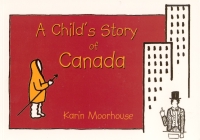| ________________
CM . . .
. Volume XI Number 9 . . . .January 7, 2005
excerpt:
Published posthumously, this book was designed to teach young children about Canada's history in a very straightforward manner. Topics include Native peoples, explorers, settlers, wars and rebellions, and the formation of the provinces. The story stops at Confederation, then leaps ahead, very briefly, to the formation of the RCMP, the cross-Canada railroad and the addition of the Yukon and the Northwest Territories to Canada. (As the author died in 1994, there is, obviously, no mention of Nunavut and the new territorial boundaries.) A new topic appears on each double-page spread, the text brief and bunched up near the top of the page, leaving lots of blank space beneath. On the left-hand page are black line illustrations, their lines thick and bold. The text reads like a primary teacher telling a story or trying to simplify the facts. However, it is somewhat inconsistent in the sophistication of its vocabulary. Much of the text contains words that youngsters will comprehend very easily, yet the author makes no attempt to explain words like "portage," "coureurs" and "revolted" and terms such as "newly independent colonies." There are some gaps in the history, and Mills uses the words "Indians" and "Eskimos," terms that are not widely used today. Though there exists a real need for Canadian history books geared toward younger audiences, this book falls short on other counts, mainly appeal, as well: cream-coloured paper, poorly placed text and too simple illustrations which beg for the addition of colour. Readers giving this book a cursory glance are likely to put it back on the shelf. In this case, the old adage is true- one can't judge a book by its cover (in fact, the cover is the only appealing illustration of the entire book). Recommended with Reservations. Gail Hamilton is a teacher-librarian at Bird's Hill School in East St. Paul, MB.
To comment
on this title or this review, send mail to cm@umanitoba.ca.
Copyright © the Manitoba Library Association. Reproduction for personal
use is permitted only if this copyright notice is maintained. Any
other reproduction is prohibited without permission.
NEXT REVIEW |
TABLE OF CONTENTS FOR THIS ISSUE
- January 7, 2005.
AUTHORS |
TITLES |
MEDIA REVIEWS |
PROFILES |
BACK ISSUES |
SEARCH |
CMARCHIVE |
HOME |
